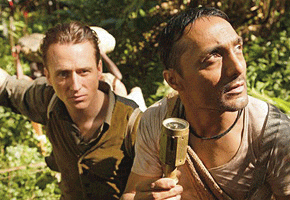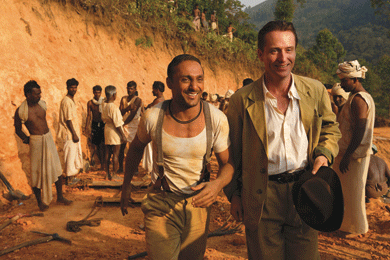
Cinema
Before The Rains
 The new film “Before the Rains” opens with vistas of blue mountaintops that plunge into deep gorges as wisps of clouds coil around their peaks. This is Kerala, in southern India, in 1937.
The new film “Before the Rains” opens with vistas of blue mountaintops that plunge into deep gorges as wisps of clouds coil around their peaks. This is Kerala, in southern India, in 1937.
By: Karl Rozemeyer *
An English plantation owner, Henry Moores (Linus Roache), and his Indian foreman, T.K. (Rahul Bose), hike through lush forest jungle to reach a hill’s pinnacle. T.K. warns that the road they plan to build through the jungle will have to change course again.
“This is going to be the crookedest road in the Crown,” Moores says, smiling.
His foreman agrees, but adds that the crooked road will survive the monsoon rains, where a straight road would be easily swept away.
“I will name this road after you,” the Englishman says wryly.
As they absorb the beauty of the landscape, the two friends contemplate the future that the road could bring, dreaming of crops of tea, cinnamon and pepper.
It is an idyll that will not last.
Moores, whose name echoes E.M. Forster’s Mrs. Moore in “A Passage to India” (1924), is “in love with India,” Roache says. “He is that adventurer that has left behind his own land, his own world and has fallen in love with this new one, and it doesn’t really fit. It is not his, and he is trying to take it. This guy is trying to have his cake and eat it, and it all falls apart.”
Roache, best known for his television work in “RFK” (2002) and the current “Law and Order,” as well as films such as “Priest” (1994) and “The Wings of the Dove” (1997), found inspiration for his character in former British colonists whom he had met during his childhood.
“I grew up in the south of England,” the actor says, “and my mum had friends who were ex-Raj. Long dead now, but I remember this one character in particular, whom I kind of remembered and held as an image of who Henry Moores was. There was a confidence and bluster and bit of tenacity and a pioneering spirit. There is a lot of courage there to go out into an unknown territory. It’s ambitious, but it’s also selfish.”
The friendship between Moores and T.K. is put to the test when Moores begins a friendship with his domestic servant, Sanjani (Nandita Das). T.K. is compelled to help his friend and boss keep the relationship under wraps upon the arrival of Moores’ wife (Jennifer Ehle) and young son from England. And when Sanjani is found murdered in a shallow pool in a nearby forested area and suspicion falls on both men, T.K. must choose between betraying the English friend who gave him a job and a future, and being accused of a crime of which he is innocent.
Bose, who has been described as “the Sean Penn of contemporary Indian cinema,” sees “Before the Rains” as a journey: “a man’s journey, finding himself torn between two worlds,” he says. “There is a world of friendship and there is a world of principles. And all of us sacrifice our principles a little bit to keep a friendship. We don’t mind entering a morally gray area to keep a friendship. But when does gray become black?”
“Before the Rains” does not, in Bose’s opinion, fit neatly into the literary and cinematic tradition of postcolonial film sagas such as “Gandhi” (1982), “Heat and Dust” (1983) and “A Passage to India” (1984).
“It is a different take on the colonizer/colonized relationship,” the Indian actor says. “They are friends. My boss doesn’t even belong to the British military administrative service. He is just a Brit entrepreneur. He is working there to make money. Even he doesn’t quite belong to the elite colonial Raj setup. There is no smell of the Raj in terms of the way it is directed and the relationship between these two people.”
Roache agrees, seeing T.K. as someone stepping between the two worlds.
“He is trying to move out of one and into the other,” Roache says, “but he is uneasy.”
Unlike the other films of the past 50 years that have been set in the twilight of the British Empire in India, this one has an Indian director, Santosh Sivan, behind the camera.
“The fact that you have got an Indian director, someone from that culture, telling the story makes it different,” Roache says. “It is not David Lean, so you don’t have that layer of interpretation happening. I think that it is pretty direct and straight. It is a real cross-cultural mix. You have an authentic sense of the British, you have an authentic sense of the Indian. And even the fact that we have made this film with Western producers and an Indian production company, it makes it a real collaboration.”
Although “Before the Rains” is presented by James Ivory of Merchant Ivory Productions, it isn’t a typical Merchant Ivory film.
“It doesn’t have that love of detail of the British way of life,” Ehle says.
“It has not been shot like an epic,” Bose adds. “With the David Lean films, with due apology, the epic was No. 1 and the story was No. 2. It was absolutely by design. You were meant to come away with the scope and scale. But with ‘Before the Rains,’ you will walk away talking about the people you met in this movie and the moral dilemma in this movie.
“It doesn’t say, ‘Look at me! You’re watching an epic,”’ he continues. “It is a very intimate film, shot by one of the finest cinematographers on earth in one of the most beautiful places on earth. If you look at it, it is very restrained in its cinematography. Anyone else would have gone berserk in Kerala and reduced the actors to two silhouetted figures in long shot.”
“Before the Rains” is loosely based on “Yellow Asphalt” (2001), a short film that producer Doug Mankoff showed to Sivan, who then decided to relocate the story to Kerala. Roache, who had previously visited India many times, hadn’t spent much time in the south or in Kerala.
“I had only been to Kerala very briefly,” he says, “so this was a new experience to be up in the hills for that amount of time. I had been there when I was 16 years old. My mum was an actress, was in ‘The Jewel in the Crown’ (1984), and then I went many times out of my own interest. I traveled quite a bit, and then went back to do this other movie. So something keeps pulling me back.”
Roache describes the area, with its “valleys and sweeping mountains with these dramatic hillsides and emerald tea plantations,” as the most beautiful place he has ever been.
As for Bose, he had visited Kerala before, but never filmed there. Along with Rajistan, he says, it is one of the most visited places in India. Sivan, he adds, is a huge star in Kerala.
“You have to understand that, when they make a movie, they put his face on the billboards, not the actor,” Bose says. “Santos’ fame in the state of Kerala is unrivaled.”
Although both are huge stars in India, Sivan and Bose had previously never worked together nor even met.
“He comes from the south of India, I am from Bombay,” Bose says. “Our paths have never crossed. When this film came about, he approached me to do this, and I think it was on the strength of a couple of other pieces of work of mine that he had seen. My character, T.K., is a south-Indian villager, and I am as urban as they get, and as westernized Indian as you get. So this was a huge leap for him to (believe that I) could pull it off.”
Yet Bose almost was never cast.
“The producers wanted me to audition,” he recalls. “And I said, ‘I don’t do auditions. I have never done them and I never will do them.’ So I refused the role. Then my manager pleaded with me. She said, ‘Put yourself on tape for two minutes, please.’ ... One day before shooting I got the cinematographer of the movie I was working on to put me on tape.
“They felt that T.K. should be played by a younger actor,” Bose adds, “so I know that they must have looked at about 50 actors. Then they saw my work.
“And the rest,” he says with a smile, “is sordid history.”
* Karl Rozemeyer is the international editor for Premiere.com